Unstrike a Match
This short movie clip appears to show a match being unstruck. The laws of physics would allow this to occur, except for one little law. A detailed narrative is available below. The clip was first shown publicly at Jim McGovern’s inaugural lecture as a Professor at the Dublin Institute of Technology on 25 September, 2008.
Narrative
In summary, this narrative is an attempt to experience time in the opposite direction to the usual. The actual story is about unstriking a match—it is the very same story as depicted in the movie (which must be among the shortest movies ever made). I hope you enjoy the movie; I have not attended acting school; excuse some of the language in the narrative for being so technical; I have tried to include some dry humour to compensate.
If you have never seen or heard a match being unstruck before, please understand that the story is told and the video presented in the opposite direction to most stories with which you may be familiar. The underlying reality is entirely ordinary. To help you follow the narrative, some frames have been taken in sequence from the video and numbered for inclusion with the text.
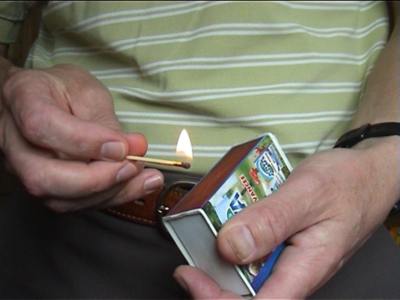
Figure 1
At the beginning, as shown in Figure 1, photons are converging on an environmentally atypical region of hot gas that surrounds and is mainly above a match-head cinder and the slightly charred adjacent surface of a wooden match that is being held still by someone's hand. The region of the gas that is bright yellow is hot, contains ps and is absorbing a lot of photons. A small proportion of these are being emitted from the retina of the owner of the hand. Some others, with a wavelength that is not that of green light, have bounced off green stripes on the owner's T-shirt before being absorbed within the flame. Yet others with skin-colour wavelengths, which left the retina of the eye of the owner of the hand have bounced off the skin of the hand with flame-colour wavelengths and continued into the flame.
Not all photons are converging on the general area of the match head, however: some light, of various colours that happen to match the surroundings, is being emitted from the almost perfectly black match head, which can be described correctly as a cinder.
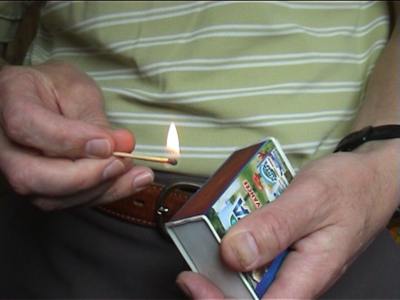
Figure 2
Figure 2 is much the same as Figure 1. This is probably the most boring part of the whole movie. Notice that the wood has uncharred. The flame now becomes bigger and more active. In the frame shown in Figure 3, energy, gases and ps are going yet more rapidly into the match head from the flame region.
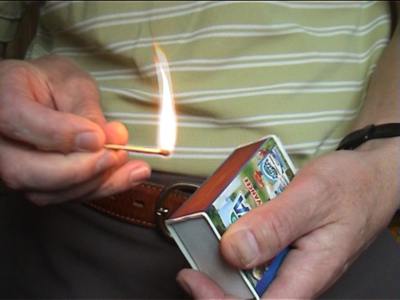
Figure 3
If you can't seem to find the humour as you read this, please realise that it is very dry. It may be best to just laugh deeply, deep inside, on the assumption that what you have already read may have been some of it.
In Figure 3 chemical change is occurring very rapidly indeed within the match head. A highly endothermic (a long word meaning: the reacting substances take in heat) reaction is occurring that will lead to the inevitable culmination of a sulphurous match head in full pristineness, having formed where the cinder had been. As the reaction proceeds there is heat transfer (as well as the mass transfer already mentioned) into the match head from the surrounding air.
The very bright areas of skin facing onto the flame are interesting. They absorb light of a range of colours and channel it into the region of the flame. To be more precise, the skin adds additional photons to the light being ‘channelled’. The additional light emitted towards the flame contains additional wavelengths and, of course, the bright skin is a net emitter of light.
Radiant heat transfer is occurring from the relatively cool surroundings to the hot flame. Convective heat transfer also exists and this involves currents of warm air, coming from above, that converge and become cooler as they lose heat to the hotter flame and flow downwards around it. The falling air continues to become progressively cooler as it descends below the level of the flame; this is because of heat loss to the hotter flame.
In terms of mixing, some interesting effects are occurring. From well above the flame and over a wide area, air of approximately atmospheric composition moves towards the flame. This gross movement is accompanied by the diffusion of carbon dioxide, sulphur dioxide, water vapour and some smoke ps from distant regions of atmospheric air where the concentrations of these substances are lower (or even very low, as in the case of sulphur dioxide) towards the region immediately above the flame where the concentrations are high.
Mechanically too, things are happening. The general downward flow of gas around the flame and the match head is facilitated by distributed, proactive forces within the gas. A temporary digression is needed to explain the jargon that has just been used: distributed proactive forces. This is jargon that is not commonly used, even by engineers or scientists. The author asks for patience on the part of the reader while he tries to explain what he means in plainer words.
Nature is fundamentally simple in that, as Albert Einstein pointed out, it is capable of being comprehended. The diversity found within nature in its phenomena, traits, orders of magnitude and variations renders it difficult to take-in and consider more than a little at time. The proactive forces that are to be explained here come in two main types, shear forces and normal forces, and for the purposes of appreciating the topic of this narrative these, too, need to be put into language that is as plain as possible.
A shear force is the type of force exerted by a brake block on the rim of a bicycle wheel, but excluding any part of the force that tends to squeeze the bicycle rim. The shear force exerted by the brake block tends to reduce the relative movement between the brake block and the wheel. A proactive shear force is the very same, but acts to increase the relative movement between the brake block and the wheel. In fact, it may be inappropriate to use the term brake block where the shear force is a proactive one; it could be called a driving block. A driving block interacts with the rim in such a way as to increase or sustain the relative movement between the rim and the block. You may not have come across examples of this, but keep an eye out, as it has been rumoured that the producer and director of ‘Unstrike a Match’ may make a sequel with a title such as ‘Unbraking a Bicycle up a Steep Corkscrew Hill’. They have, of course, denied the rumours.
If a bicycle wheel is stationary with respect to a brake block, or a driving block, there can be a shear force between the two: whether it is regarded as a friction force or a driving force depends on what happens next; it depends on the direction in which the story is told. Whereas for a bicycle going down a hill with the brakes being applied, the shear forces between the brake blocks and the wheel rims are just ordinary friction forces, in the not-proposed movie ‘Unbraking a Bicycle up a Steep Corkscrew Hill’, the shear forces between the brake blocks and the rim of the bicycle would be driving forces. The supposed would-be producer and director are not hesitant to admit that they are more enthralled by driving block forces than they are by brake block forces. 'Where does the driving energy come from?', you may ask. Energy is conserved. These driving blocks simply become cooler as they unbrake the bicycle up the hill. They start off by being hot (and how they became hot would be another story), but as they cool down and simultaneously accept heat transfer from the cooler surroundings they use that same energy to drive the bicycle rim.
An example of a normal force would be the force exerted by a brake block on the rim of a bicycle wheel that tends to squeeze the bicycle rim. It is at right angles to, or normal to, the force that tends to change the relative sliding movement between the block and the rim.
Having explained shear forces and normal forces by way of an example that involved a bicycle, the narrative now returns to the gas surrounding the match head. It turns out that imagining an arbitrary plane within the gas at a position of interest is a good way of investigating and describing the mechanics of what is happening there. Shear forces and normal forces can exist over any imaginary plane or surface within the gas. Of course shear forces and normal forces can also exist over any real surface that the gas is in contact with, such as, for example, a small part of the surface of the match head or the shaft of the match. Unlike solids, gases cannot withstand shear forces: they yield to them. To put this more concisely: wherever frictional shear stress exists within the gas, relative movement occurs. The rate of relative movement is proportional to the local shear stress. This is the traditional textbook story about shear stress in fluids. If the story is told in the opposite direction then the frictional shear stresses are in fact proactive driving shear forces. It is as though honey in a jar develops proactive driving shear forces distributed within itself and does this while conserving energy. The random kinetic energy of the molecules that make up the honey would become less random and by acting in a concerted rather than random way on a spoon push it against a hand that, for its part, allows the motion while matching the force applied by the honey. Likewise, coming back to the match, proactive forces are involved in doing work within the body of the gas, reorganizing it, increasing its kinetic energy, or creating variations in pressure from region to region within it. As energy is conserved, the average temperature of the gas decreases accordingly—recall the opening scene of the movie: you have to imagine and believe that the gas surrounding the match head is hot!
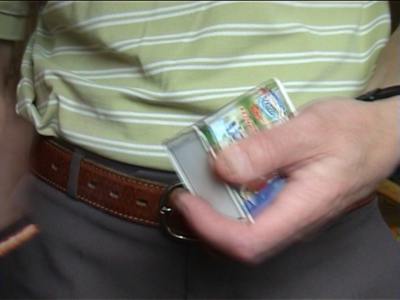
Figure 4
In Figure 4 the hand holding the match has moved out of the frame to the left (if this were a stage play the script would contain the note ‘Exit hand, stage right.’ The blurring of the hand containing the match box in this frame is an indication of its upward movement in anticipation of the arrival of the match head to make contact with the very end of the strike strip (what precision!). In order for the match box to apply the right reaction force to the match at the moment of contact, the match, the box and the two hands must have established the right momenta. In advance of the frame shown in Figure 4, and having gone some distance out of the frame to the left, the match-holding hand had come momentarily to rest before moving back and continuing to accelerate towards the matchbox.
It can be seen from the movie that as the match head approaches the friction strip on the box the flame has reduced to a very small size. The match had exerted forces on the hand that was holding it, first one way and then the opposite way, as it briefly left the frame of view and returned.
Inertia effects are at play and, as the masses of the hands and the arms attached to them are much greater than the mass of the match, the latter is very much a minor player. However, the match has more of the initiative! The arm and the hand are being controlled to respond to what the match ‘does’. Of course, the match is inanimate and so the liberty that is being taken here with the use language should be excused. The surrounding air also has initiative!
After the above manoeuvre, the match is at the end of the strike strip and moving towards it at speed. The match head then makes a hard landing on the very end of the strip. Just before making contact, the surface of the match head is at a high temperature that it has acquired progressively by accepting heat transfer from the cooler surroundings. In fact, the region of impending contact on the strike strip is at a similarly high surface temperature, which it too arrived at progressively by accepting heat transfer from the cooler surroundings.
Having made contact, the match continues both to be dragged along by the strip and to pull the hand as it moves along the strip. The match head happens to follow a rather imperceptible mark that already exists on the strike strip, effacing it totally and without trace. The mark in fact reacts chemically as well as physically with the match head that effaces it.
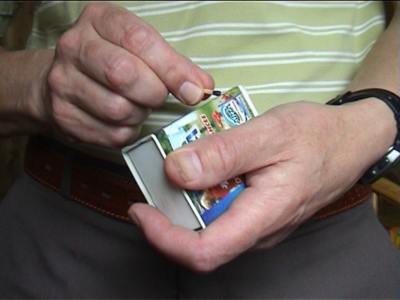
Figure 5
As it comes to rest in contact with the strike strip, the match head is chemically homogeneous with a smooth, rounded surface. Figure 5 shows the final frame of the movie. While it had been moving over the strike strip, the match had been pulling the hand.
Sound waves bounce around in much the same way as light waves. Their velocity is much slower, however. The noise that can be heard in the movie is representative of environmental noise that contributes in a causative way to the movements and even the chemical reactions that appear to take place.
In what seems to be depicted in the video ‘Unstrike a Match,’ the laws of physics are fully satisfied throughout, except for one little law, which is known as the Second Law of Thermodynamics. This law says that heat transfer cannot occur spontaneously from regions at higher temperatures to regions at lower temperatures. Although we have seen exactly how the act of unstriking a match might occur, it never does occur, or rather nothing of that type has ever been verified to have occurred.
The Second Law seems to imply that the time does not possess directional symmetry: time can only march forward. I suspect that, somehow, distance and time are one and the same thing and that a mere instant of our existence is a vast distance in spacetime (perhaps 1 second equals approximately 3 × 108 metres). Perhaps our existence is a sequence of ‘frames’ in spacetime and from within that sequence it is not possible to experience time in reverse. An analogy might be: while travelling continuously forwards along a train track from A to B it is not possible to experience the distance travelled decreasing.
I hope you didn’t find the going too heavy. If you find you prefer the movie to the book, that's fine by me. I hope, at least, you enjoyed the humour.

